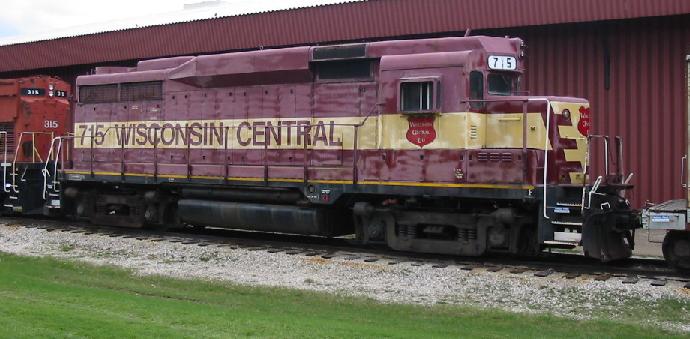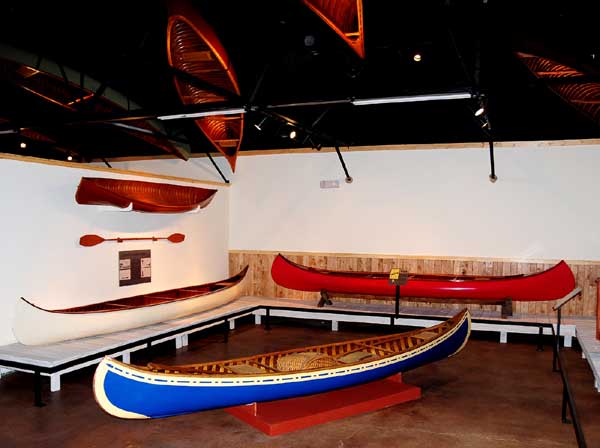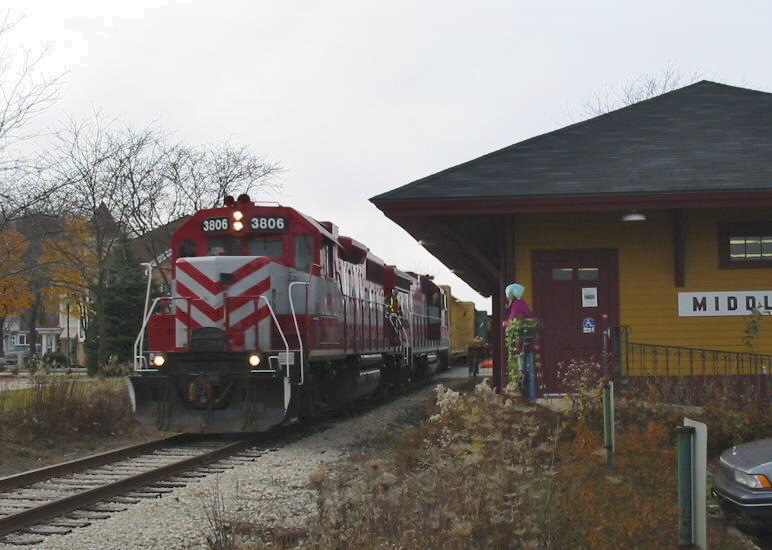|
Soo Line 2719
Soo Line 2719 is a 4-6-2 "Pacific" type steam locomotive built by the American Locomotive Company (ALCO) for use on passenger trains operated by the Minneapolis, St. Paul and Sault Ste. Marie Railway (" Soo Line"). No. 2719 was used to haul the Soo Line's last steam-powered train, a June 21, 1959 round-trip excursion between Minneapolis, Minnesota and Ladysmith, Wisconsin. It was then displayed in Eau Claire, Wisconsin until 1996. It was restored and operated in excursion service from 1998 until 2013 when its boiler certificate expired. Today, the locomotive remains on static display in Duluth, Minnesota. History Revenue service No. 2719 was built by the American Locomotive Company (ALCO) in May, 1923 in Schenectady, New York. It was one of 6 H-23 class 4-6-2 “Pacific” type steam locomotives built for the Minneapolis, St. Paul and Sault Ste. Marie Railroad, better known as the Soo Line Railroad. At some point in the mid-1940s, the locomotive became one of a few H- ... [...More Info...] [...Related Items...] OR: [Wikipedia] [Google] [Baidu] |
Two Harbors, Minnesota
Two Harbors is a city in and the county seat of Lake County, Minnesota, United States, along the shore of Lake Superior. The population was 3,633 at the 2020 census. Minnesota State Highway 61 serves as a main route in Two Harbors. Gooseberry Falls State Park is to the northeast and the city is home to a cargo shipping port for mined iron ore. History In the early years Two Harbors consisted of two separate communities, Agate Bay and Burlington. The village of Burlington along Burlington Bay was platted in 1856, first incorporated on May 23, 1857; it had a post office that operated from 1856 until 1862. The first residence constructed in Agate Bay was owned by Thomas Sexton (1854); it was a 14-by-16-foot shack. Early settlers lived in primitive conditions, which was common for both the area and time. Their homes were made of logs and had dirt floors. Diets often consisted of homegrown vegetables and animals caught in the area (at that time there were many dense forests, so de ... [...More Info...] [...Related Items...] OR: [Wikipedia] [Google] [Baidu] |
Schenectady
Schenectady () is a city in Schenectady County, New York, United States, of which it is the county seat. As of the 2020 census, the city's population of 67,047 made it the state's ninth-largest city by population. The city is in eastern New York, near the confluence of the Mohawk and Hudson rivers. It is in the same metropolitan area as the state capital, Albany, which is about southeast. Schenectady was founded on the south side of the Mohawk River by Dutch colonists in the 17th century, many of whom came from the Albany area. The name "Schenectady" is derived from the Mohawk word ''skahnéhtati'', meaning "beyond the pines" and used for the area around Albany, New York. Residents of the new village developed farms on strip plots along the river. Connected to the west by the Mohawk River and Erie Canal, Schenectady developed rapidly in the 19th century as part of the Mohawk Valley trade, manufacturing, and transportation corridor. By 1824, more people worked in manufacturi ... [...More Info...] [...Related Items...] OR: [Wikipedia] [Google] [Baidu] |
Altoona, Wisconsin
Altoona is a city in Eau Claire County, Wisconsin, United States. The population was 8,292 at the 2020 census with an estimated population in 2021 of 8,817. The city is a railroad terminal on the Union Pacific Railroad. History The settlement of Altoona began in 1881 when the Chicago, St. Paul, Minneapolis and Omaha Railway selected the site for a new terminal to replace the overcrowded existing terminal in Eau Claire. The railroad had originally planned to put the new terminal in Fall Creek, but the city of Eau Claire lobbied for a site closer to the existing one, and representatives from Eau Claire and the railroad walked the tracks from Fall Creek to Eau Claire to determine a suitable site. When the location of present-day Altoona - approximately three miles east of the existing Eau Claire terminal - was found to have sufficient flat land and access to water (via the Eau Claire River), the railroad began construction of the new terminal and the community of "East Eau Clair ... [...More Info...] [...Related Items...] OR: [Wikipedia] [Google] [Baidu] |
Railway Roundhouse
A railway roundhouse is a building with a circular or semicircular shape used by railways for servicing and storing locomotives. Traditionally, though not always the case today, these buildings surrounded or were adjacent to a turntable. Overview Early steam locomotives normally traveled forwards only. Although reverse operations capabilities were soon built into locomotive mechanisms, the controls were normally optimized for forward travel, and the locomotives often could not operate as well in reverse. Some passenger cars, such as observation cars, were also designed as late as the 1960s for operations in a particular direction. Turntables allowed locomotives or other rolling stock to be turned around for the return journey, and roundhouses, designed to radiate around the turntables, were built to service and store these locomotives. Most modern diesel and electric locomotives can run equally well in either direction, and many are push-pull trains with control cabs at ea ... [...More Info...] [...Related Items...] OR: [Wikipedia] [Google] [Baidu] |
Canadian National Railway
The Canadian National Railway Company (french: Compagnie des chemins de fer nationaux du Canada) is a Canadian Class I freight railway headquartered in Montreal, Quebec, which serves Canada and the Midwestern and Southern United States. CN is Canada's largest railway, in terms of both revenue and the physical size of its rail network, spanning Canada from the Atlantic coast in Nova Scotia to the Pacific coast in British Columbia across approximately of track. In the late 20th century, CN gained extensive capacity in the United States by taking over such railroads as the Illinois Central. CN is a public company with 22,600 employees, and it has a market cap of approximately CA$90 billion. CN was government-owned, having been a Canadian Crown corporation from its founding in 1919 until being privatized in 1995. , Bill Gates is the largest single shareholder of CN stock, owning a 14.2% interest through Cascade Investment and his own Bill and Melinda Gates Foundation. Fr ... [...More Info...] [...Related Items...] OR: [Wikipedia] [Google] [Baidu] |
Wisconsin Central Ltd
Wisconsin Central Ltd. is a railroad subsidiary of Canadian National. At one time, its parent Wisconsin Central Transportation Corporation owned or operated railroads in the United States, Canada (Algoma Central Railway), the United Kingdom ( English Welsh & Scottish), New Zealand (Tranz Rail), and Australia (Australian Transport Network). Overview Wisconsin Central Ltd. (WC) started in US in the mid-1980s using most of the original Wisconsin Central Railway's rights of way and some former Milwaukee Road rights of way after the Soo Line Railroad acquired the Wisconsin, Illinois, Indiana, Missouri and Minnesota holdings of the bankrupt Milwaukee Road and divested its older railway trackage in Wisconsin. In 1993 the Wisconsin Central also acquired the Green Bay and Western Railroad and the Fox River Valley Railroad. In 1995, Wisconsin Central acquired the Canadian Algoma Central Railway whose tracks ran north of Sault Saint Marie to Hearst, Ontario. The Algoma Central runs a p ... [...More Info...] [...Related Items...] OR: [Wikipedia] [Google] [Baidu] |
Spooner, Wisconsin
Spooner is a city in Washburn County, Wisconsin, United States. The population was 2,573 at the 2020 census. The city is located mostly within the southwest corner of the Town of Spooner, with a small portion extending into the Town of Beaver Brook on the south, the Town of Bashaw on the southwest, and the Town of Evergreen on the west. The city's nickname, Crossroads of the North, is a reference to the city's location at the junction of two U.S. highways, 53 and 63, and State Highways 70 and 253. History Originally a town in the year 1889, and thereafter officially incorporated a city in the year 1909, Spooner's history is closely interlaced with that of railroad history. In the year 1879, the North Wisconsin Railway was constructed due north of the present-day city of Spooner. Following that, the operations of that railroad were moved south where it then joined the Chicago and Northwestern at what was then coined as Chicago Junction. The community, then initially only ... [...More Info...] [...Related Items...] OR: [Wikipedia] [Google] [Baidu] |
Wisconsin Great Northern Railroad
The Wisconsin Great Northern Railroad operates a historic train line centered in Trego, Wisconsin on 26 miles of track, between Spooner, Wisconsin and Springbrook, Wisconsin. It was founded on April 1, 1997. The line runs dinner trains, bed and breakfast trains, and scenic sight seeing tours. Locomotives * LS&M #41 - GE 50-Ton Diesel Locomotive (likely built in 1941) * WGN #314 - Former Green Bay & Western Alco C424 Diesel Locomotive (privately owned) * WGN #423 - Former Chicago & North Western EMD F7 * WGN #600 - Former B&OCTRR EMD SW1 * WGN #862 - Former Milwaukee Road EMD SW1 * WGN #891 - Former Milwaukee Road or Erie Railroad EMD SW1 * WGN #1280 - Former American Can/Marathon Southern EMD SW600 * WGN #1386 - Former TP EMD GP35M * WGN #1387 - Former MP EMD GP35M * WGN #1388 - Former TP EMD GP35M * WGN #1950 - Former Great Northern EMD F7 * WGN #1951 - Former Great Northern EMD F7 * WGN #6006 - Former Algoma Central Railway SD40-2, used for freight * WGN #8760 - Rebuilt 1949 ... [...More Info...] [...Related Items...] OR: [Wikipedia] [Google] [Baidu] |
Wisconsin And Southern Railroad
The Wisconsin and Southern Railroad is a Class II regional railroad in Southern Wisconsin and Northeastern Illinois currently operated by Watco. It operates former Chicago, Milwaukee, St. Paul and Pacific Railroad (Milwaukee Road) and Chicago and North Western Railway (C&NW) trackage, mostly acquired by the state of Wisconsin in the 1980s. Within Wisconsin, WSOR connects with four western Class I railroads: BNSF Railway, Canadian National Railway, Canadian Pacific Railway, and Union Pacific Railroad. Through trackage rights over Metra, WSOR accesses Chicago to connect with the two eastern Class I railroads, CSX Transportation and Norfolk Southern Railway. WSOR also has access to harbor facilities in Prairie du Chien, and transload facilities are located in Milwaukee, Janesville, Madison, and Oshkosh. 22 grain elevators have located rail load-out facilities on the WSOR system. For train operation purposes, the WSOR system is divided into two divisions, the Northern Division ... [...More Info...] [...Related Items...] OR: [Wikipedia] [Google] [Baidu] |
Soo Line 1003
Soo Line 1003 is a class "L-1" 2-8-2 "Mikado" type steam locomotive built by the American Locomotive Company (ALCO) in March 1913 as a member of the Minneapolis, St. Paul and Sault Ste. Marie Railroad ("Soo Line") L-1 class. It was retired from regular revenue service in August 1959 and restored to operating condition on October 27, 1996. Today, it is occasionally operated on the major railroads of the American Upper Midwest. History Revenue service The locomotive was built in 1913 by the American Locomotive Company (ALCO). It was used by the Soo Line until retirement in August 1959, when it went into serviceable storage in Gladstone, Michigan as part of the railroad's strategic reserve. On December 30, 1959, the railroad donated the locomotive to the city of Superior, Wisconsin where it was put on public display. In the mid 1970s, Superior Shortline Steam Railroad Ltd. was organized to restore the locomotive to operations. Excursion service The locomotive was sold partia ... [...More Info...] [...Related Items...] OR: [Wikipedia] [Google] [Baidu] |
2-8-2
Under the Whyte notation for the classification of steam locomotives, represents the wheel arrangement of two leading wheels on one axle, usually in a leading truck, eight powered and coupled driving wheels on four axles and two trailing wheels on one axle, usually in a trailing truck. This configuration of steam locomotive is most often referred to as a Mikado, frequently shortened to Mike. At times it was also referred to on some railroads in the United States of America as the McAdoo Mikado and, during World War II, the MacArthur. The notation 2-8-2T indicates a tank locomotive of this wheel arrangement, the "T" suffix indicating a locomotive on which the water is carried in tanks mounted on the engine rather than in an attached tender. Overview The 2-8-2 wheel arrangement allowed the locomotive's firebox to be placed behind instead of above the driving wheels, thereby allowing a larger firebox that could be both wide and deep. This supported a greater rate of combustion ... [...More Info...] [...Related Items...] OR: [Wikipedia] [Google] [Baidu] |
Northern Pacific Class S-10
The Northern Pacific class S-10 (NP S-10) was a type of steam locomotive in use on American railroads in the early 20th century. The first engines of the type were introduced in 1905, and ten were acquired by the Northern Pacific Railway (NP) in 1907, continuing in service until the 1930s and 1940s. One of the engines, Specifically No.328, has been preserved. Entry into service The Chicago Southern railroad was incorporated in 1904 by John R. Walsh, to build part of a Chicago, Illinois to Terre Haute, Indiana line. Twelve 2-6-0, eight 4-4-0 and twenty 4-6-0 locomotives were ordered from the Rogers works of the American Locomotive Company in Paterson, New Jersey. The first six 4-6-0's were delivered in August 1905. The remaining fourteen were held by the builder because the railroad entered bankruptcy and sat, mostly complete, awaiting a new buyer. In 1907, the Northern Pacific was short of power and purchased ten of the fourteen 4-6-0 locomotives remaining at the builder's ... [...More Info...] [...Related Items...] OR: [Wikipedia] [Google] [Baidu] |








